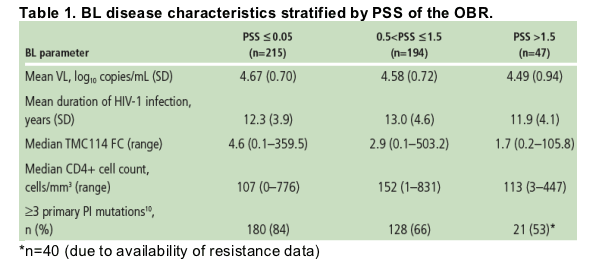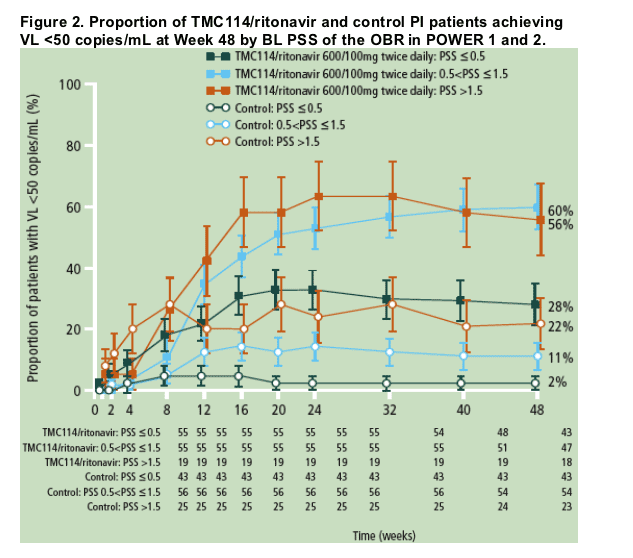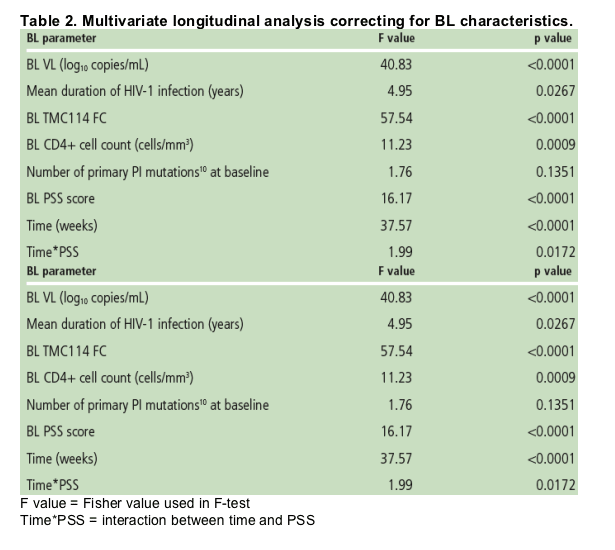 |
 |
 |
| |
Impact of optimised background regimen on virological response to TMC114 with low-dose ritonavir in POWER 1, 2 and 3, as measured by the phenotypic susceptibility score
|
| |
| |
Vangeneugden T,1 Winters B,2 Bacheler L,3 Picchio G,3 de Bˇthune M-P,1 McKenna P,2 Miralles D1
1Tibotec BVBA, Mechelen, Belgium; 2Virco BVBA, Mechelen, Belgium; 3VircoLab, Inc., Durham, NC, USA
"...PSS (phenotypic susceptibility score) of the OBR (optimized background regimen) was a strong predictor of Week 24 virological response: 34%, 49% and 52% of patients with PSS 1.5, respectively achieved HIV RNA <50 copies/mL...... After correcting for prognostic baseline disease characteristics, the PSS score was highly significant. The estimated changes from baseline in viral load at Week 24 were close to the observed mean changes and were predicted to be -1.50, -1.94 and -2.57 log10 copies/mL for patients with PSS 1.5, respectively. Baseline TMC114 fold-change was the strongest prognostic factor..... The number of primary PI mutations at BL was not significant when accounting for other prognostic factors included in the model...."
AUTHOR CONCLUSIONS
BL PSS of the OBR was a strong predictor of virological response for all patients, with greater proportions of patients with a high PSS achieving HIV RNA <50 copies/mL and greater VL reductions from BL at Weeks 24 and 48.
Virological response to TMC114/ritonavir treatment was consistently greater than the response to investigatorselected PIs in the control group, regardless of PSS subgroup.
Multivariate statistical analysis confirmed that the PSS of the OBR was predictive of virological response after correcting for prognostic BL disease characteristics.
ABSTRACT
Background: TMC114 (darunavir) with low-dose ritonavir (TMC114/ritonavir) showed significant antiviral efficacy in treatment-experienced patients in POWER 1, 2 and 3 (TMC114-C213, TMC114-C202, TMC114-C215/C208) with 42% of patients reaching HIV RNA <50 copies/mL at Week 24. This analysis describes the impact of the baseline (BL) phenotypic susceptibility score (PSS) of the optimised background regimen (OBR, consisting of NRTIs with or without enfuvirtide), as determined by virco TYPE HIV-1 v4.0.00, on virological response.
Methods: In POWER 1, 2 and 3, 458 patients initiated treatment with TMC114/ritonavir 600/100mg twice-daily, the recommended dose for treatment-experienced patients.Week 24 and 48 virological response analyses
were intent-to-treat (ITT) (non-completer = failure for change in viral load [VL], and time-to-loss of virological response [TLOVR] for the proportion reaching HIV RNA <50 copies/mL).
Susceptibility of the NRTIs in the OBR was determined by virco TYPE HIV-1 v4.0.00. The total PSS was calculated as the sum of total NRTI PSS, +1 if enfuvirtide was used for the first time. Subgroup analyses were performed by total PSS (1.5). Multivariate models correcting for BL characteristics were applied to estimate the change in VL.
Results:
In POWER 1, 2 and 3 at BL, 47%, 43% and 10% of patients had a PSS of 1.5, respectively.
PSS of the OBR was a strong predictor of Week 24 virological response: 34%, 49% and 52% of patients with PSS <./=0.5, 0.5-1.5 and >1.5, respectively achieved HIV RNA <50 copies/mL.
A similar trend was observed in POWER 1 and 2 at Week 48 for both the control group (2%, 11% and 22%, respectively) and the TMC114/ritonavir 600/100mg twice-daily group (28%, 60% and 56%, respectively).
Similar results were observed for change in VL. Multivariate analyses correcting for other BL prognostic factors confirmed these observations.
Conclusions: BL PSS of the OBR, as determined by the virco TYPE HIV-1 v4.0.00, was a strong predictor of virological response. Response to TMC114/ritonavir treatment in the group of patients with the lowest PSS was
still higher than for control, regardless of subgroup.
METHODS
Patients in POWER 1, 2 and 3 were PI-, NRTI- and NNRTI-experienced (prior treatment with >/=2 NRTIs for at least 3 months, with >/=1 NNRTI in a failing regimen and with 31 PI for at least 3 months) with plasma HIV-1 RNA >1,000 copies/mL and >/=1 primary PI mutation (based on the 2003 IAS-USA guidelines8 and updated in 2004 to include D30N, L33F/I, M46I/L, G48V, I50L/V, V82A/F/L/S/T, I84A/C/V and L90M9).
All patients who initiated treatment with TMC114/ritonavir 600/100mg twice-daily in the three POWER trials were included in this analysis (n=458), along with patients who were randomised to receive one or more investigatorselected
control PIs (n=124) in POWER 1 and 2.
In addition to TMC114/ritonavir or control PIs, patients received an OBR consisting of two or more NRTIs with or without enfuvirtide, and excluding NNRTIs. Selection of the OBR was based on genotypic resistance testing
(Virtual PhenotypeTM from Virco ) and prior antiretroviral treatment history.
Pooled analyses of patients in the POWER 1, 2 and 3 trials were carried out at Week 24.Week 48 analyses only included patients from POWER 1 and 2, as data from the POWER 3 study were not yet available beyond 24 weeks.
Week 24 and 48 analyses of the virological endpoints (change in VL and HIV RNA <50 copies/mL) were conducted on the ITT population (non-completer = failure for change in VL and TLOVR for the proportion of patients reaching HIV
RNA <50 copies/mL).
Phenotypic susceptibility of the NRTIs in the OBR was determined using virco TYPE HIV-1 v4.0.00. PSSs were assigned to each NNRTI in the OBR as follows. Individual NRTIs in a patientÕs OBR were given a PSS of 1 by virco TYPE HIV-1 v4.0.00 if the fold change (FC) in EC50 value predicted for a particular NRTI by Virtual PhenotypeTM-LM was < clinical cutoff (CCO) 1, a PSS of 0.5 if the predicted FC was between CCO1 and CCO2, or a PSS of 0 if the predicted FC was >CCO2. The total PSS of the OBR was calculated as the sum of the PSS of susceptible NRTIs in the OBR, +1 if the patient was using enfuvirtide for the first time in the OBR. Subgroup analyses were performed in terms of total PSS, for patients with scores of >/=0.5, 0.5-1.5, or >1.5. Multivariate models correcting for BL characteristics, including VL and number of IAS-USA primary PI mutations, were also applied to estimate the prognostic effect of BL characteristics on the change in VL at 24 weeks.
The study protocol was reviewed and approved by the appropriate constitutional ethics committee(s) and health authorities, and was conducted in accordance with the Declaration of Helsinki.
RESULTS
BL disease characteristics
A total of 458 patients in POWER 1, 2 and 3 initiated treatment with TMC114/ritonavir 600/100mg twice-daily and were included in this analysis. Of these patients, 131 were enrolled in the POWER 1 and 2 studies and 327 were from POWER 3.
In POWER 1, 2 and 3 at BL, 47%, 43% and 10% of patients had a PSS of 1.5, respectively. Patients with a PSS >1.5 tended to have fewer primary PI mutations, with a lower VL and TMC114 FC (Table 1).

Impact of BL PSS on virological response: VL <50 copies/mL
Overall at Week 24, 42% of patients receiving TMC114/ritonavir 600/100mg twice-daily in POWER 1, 2 and 3 (n=458) achieved VL <50 copies/mL. At Week 48, combined analysis of POWER 1 and 2 showed 46% of patients receiving
TMC114/ritonavir 600/100mg twice-daily (n=110) and 10% of patients receiving control PIs (n=120) achieved VL <50 copies/mL.
PSS of the OBR was a strong predictor of Week 24 virological response: 34%, 49% and 52% of patients with PSS 1.5, respectively achieved HIV RNA <50 copies/mL (Figure 1).

A similar trend in terms of correlation between PSS and virological response was observed in POWER 1 and 2 at Week 48 for both the control group (2%, 11% and 22%, respectively) and the TMC114/ritonavir 600/100mg twice-daily group (28%, 60% and 56%, respectively) (Figure 2).

Impact of BL PSS on virological response: change in VL from BL
Overall at Week 24, patients receiving TMC114/ritonavir 600/100mg twice-daily in POWER 1, 2 and 3 (n=458) had a mean VL decrease from BL of -1.74 log10 copies/mL. At Week 48, combined analysis of POWER 1 and 2 showed patients receiving TMC114/ritonavir 600/100mg twice-daily (n=109) had a mean VL decrease of -1.63 log10 copies/mL and patients receiving control PIs (n=119) had a mean VL decrease of -0.35 log10 copies/mL.
In terms of change in VL from BL, patients receiving TMC114/ritonavir 600/100mg twice-daily who had a higher PSS had a larger decrease in VL at Week 24 (Figure 3).

A similar trend was observed for change in VL by PSS at Week 48 for patients receiving TMC114/ritonavir or control PIs in POWER 1 and 2 (Figure 4). Responses of patients receiving TMC114/ritonavir 600/100mg twice-daily were
consistently higher than those of the control group, regardless of PSS subgroup.
Multivariate analyses
A multivariate longitudinal analysis was performed on the change from BL in VL, using a linear mixed model, that included all observed VL data for all 458 patients. This model accounted for serial correlation using an unstructured
variance-covariance matrix. The BL disease characteristics from Table 1 were included as fixed effects together with the baseline PSS score, time and their interaction.
After correcting for prognostic BL disease characteristics, the PSS score was highly significant (Table 2). The estimated changes from BL in VL at Week 24 were close to the observed mean changes and were predicted to be -1.50, -1.94
and -2.57 log10 copies/mL for patients with PSS 20.5, 0.5-1.5 and >1.5, respectively. BL TMC114 FC was the strongest prognostic factor, with a low p value and the highest F value. The number of primary PI mutations at BL was not
significant (p=0.1351) when accounting for other prognostic factors included in the model.


|
| |
|
 |
 |
|
|